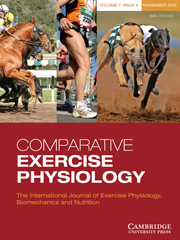Article contents
Effects of pre-exercise intrapulmonary blood inoculation on equine pulmonary function during supramaximal exercise
Published online by Cambridge University Press: 01 February 2008
Abstract
This study was designed to determine the effect of 200 ml of autologous blood instilled in the lungs of healthy horses had on gas exchange, maximal oxygen consumption  and breathing mechanics during supramaximal exercise, as a model of exercise-induced pulmonary haemorrhage (EIPH). The subjects were six healthy well-conditioned Thoroughbred horses. On four occasions over a 6-week period, six horses were subjected to two bouts of exercise to fatigue per day, each at speeds equated with an oxygen requirement that was 110% of
and breathing mechanics during supramaximal exercise, as a model of exercise-induced pulmonary haemorrhage (EIPH). The subjects were six healthy well-conditioned Thoroughbred horses. On four occasions over a 6-week period, six horses were subjected to two bouts of exercise to fatigue per day, each at speeds equated with an oxygen requirement that was 110% of  . Prior to the second bout of exercise on each day, the horses underwent bilateral bronchoscopy during which either nothing (control), or 200 ml of saline, plasma or blood was inoculated into the distal airways, divided equally between each lung. Run time to fatigue,
. Prior to the second bout of exercise on each day, the horses underwent bilateral bronchoscopy during which either nothing (control), or 200 ml of saline, plasma or blood was inoculated into the distal airways, divided equally between each lung. Run time to fatigue,  and measurements of pulmonary gas exchange and breathing mechanics were made and analysed for the effects of the four treatments (control, saline, plasma and blood). Inoculation of blood significantly reduced pulmonary oxygen exchange,
and measurements of pulmonary gas exchange and breathing mechanics were made and analysed for the effects of the four treatments (control, saline, plasma and blood). Inoculation of blood significantly reduced pulmonary oxygen exchange,  and run time to fatigue. Plasma inoculation caused intermediate effects, adversely affecting arterial oxygen tension but without significantly reducing
and run time to fatigue. Plasma inoculation caused intermediate effects, adversely affecting arterial oxygen tension but without significantly reducing  or run time to fatigue. Saline treatment had no effect. None of the treatments had an effect on ventilatory mechanics. The results of this study suggest that volumes of blood in the order of 200 ml can impair gas exchange and interfere with the ability of horses to exercise at supramaximal intensities. Blood volumes of this magnitude are readily evident endoscopically, and probably reflect a moderate-to-severe level of EIPH, in contrast to previously published studies where the unilateral instillation of 100 ml of blood or less did not affect performance.
or run time to fatigue. Saline treatment had no effect. None of the treatments had an effect on ventilatory mechanics. The results of this study suggest that volumes of blood in the order of 200 ml can impair gas exchange and interfere with the ability of horses to exercise at supramaximal intensities. Blood volumes of this magnitude are readily evident endoscopically, and probably reflect a moderate-to-severe level of EIPH, in contrast to previously published studies where the unilateral instillation of 100 ml of blood or less did not affect performance.
- Type
- Research Paper
- Information
- Copyright
- Copyright © Cambridge University Press 2008
References
- 3
- Cited by


